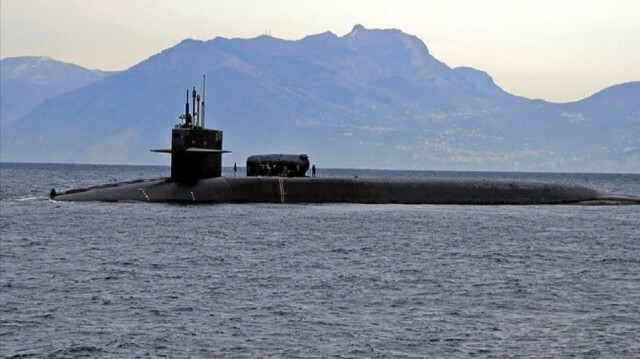
The abrupt announcement of the AUKUS defense pact among the US, the UK and Australia has raised eyebrows over the arms race in the deeper Pacific region. Besides, it has also brought to focus several defense pacts that the regional countries have signed in the past.
The US has made most of the defense pacts signed with regional countries in Asia-Pacific.
Under the new AUKUS defense pact announced last week, Australia will be provided technology by Washington and London to build nuclear-powered submarines.
The AUKUS effectively stripped France from a $90 billion defense deal with Australia, triggering a diplomatic crisis between Paris, Canberra, and Washington.
The regional countries have expressed concern over the transfer of nuclear technology and a potential arms race, however, Canberra has stressed that it has no desire to acquire nuclear weapons or civil nuclear capability.
The new defense pact is seen as another grouping to counter China's expanding economic and military influence in the wider Asia-Pacific region, with the South China Sea in focus.
Besides AUKUS, the US is leading Quad – a loose security alliance with Australia, Japan and India. The Quad is holding its first in-person meeting in Washington this week.
China and North Korea have opposed the AUKUS calling it a peace disruptor, while Indonesia fears it may trigger an arms race in the region.
"The declaration of the AUKUS has come with a surprise for the world," said Selcuk Colakoglu, Associate Professor of Globalisation and Development Programme at Beijing Normal University Hong Kong Baptist University.
"It seems that India and Japan, the Quad's other members together with Australia and the US, are not very happy with the sudden appearance of AUKUS. New Delhi and Tokyo likely consider that the new trilateral alliance has diluted the Quad's significance," Colakoglu told Anadolu Agency.
"The first Quad leaders' summit will be the first early test whether the establishment of AUKUS has undermined the Quad."
- FDPA - 1971
The 50-year-old Five Power Defense Arrangements (FPDA) are several bilateral defense relationships and mutual cooperation among Australia, Malaysia, New Zealand, Singapore, and the UK.
Signed in 1971, the FDPA enjoins upon its members to consult each other "immediately" in the event or threat of an armed attack on any of these five countries to decide what measures should be taken jointly or separately in response.
The FDPA is the result of a series of multi-lateral agreements between these countries.
- Philippine Treaty - 1951
The US signed a bilateral treaty with the Philippines on Aug. 30, 1951, in which each of the two countries recognized that an armed attack in the Pacific Area on either of the two parties would be "dangerous to its own peace and safety."
The two countries agree that they "will act to meet the common dangers in accordance with its constitutional processes."
Manila also signed the Visiting Forces Agreement with Washington, which was ratified in 1999.
The treaty, renewed in July after dilly-dallying by President Rodrigo Duterte's government, exempts US military personnel from passport and visa regulations in the Philippines.
- US, New Zealand and Australia - 1951
The US, New Zealand and Australia signed a treaty on Sept. 1, 1951, which is almost similar to one Washington signed with Manila a month earlier.
The three-member states recognize that an armed attack in the Pacific Area on any of the three-member states "would be dangerous to its own peace and safety."
The treaty declares that it would act to meet the common danger in "accordance with its constitutional processes."
- Southeast Asia Treaty - 1954
Three years later, the US, Australia, France, New Zealand, Philippines, Thailand, and the UK signed a treaty on Sept. 8, 1954, whereby each party "recognizes that aggression by means of armed attack in the treaty area against any of the parties would endanger its own peace and safety and each will in that event act to meet the common danger in accordance with its constitutional processes."
- SEATO – 1954 to 1977
In September 1954, the Southeast Asia Treaty Organization (SEATO) came into being under the popular Manila Pact.
The eight-member multi-national organization stood for what it called "collective defense" in Southeast Asia created by the Southeast Asia Collective Defense Treaty, or Manila Pact.
It primarily appeared a bloc to halt further communist gains in the region with Washington at its back.
However, it did not withstand internal bickering and disputes resulting in its demise on June 30, 1977, as many of its members withdrew.
- Japan defense treaty - 1960
The US signed a defense treaty on Jan. 19, 1960.
It replaced a security treaty that was signed between the two countries on Sept. 8, 1951.
The content of the 1960 defense treaty is almost similar to the ones signed with other regional countries, however, with a caveat, i.e., this treaty covers the territories which are under the administration of Japan, thereby meaning the disputed island which is also claimed by Russia.
The US has its army bases in the country.
- South Korea defense treaty – 1953
The Korean War in the 1950s between the North and South ended in an armistice on July 27, 1953, but there has never been a peace treaty between the divided Koreas.
Washington signed a treaty with Seoul on Oct. 1, 1953, whereby the two countries recognized that an armed attack in the Pacific area on either of the parties would be "dangerous to its own peace and safety."
"Each party would act to meet the common danger in accordance with its constitutional processes," the treaty says.
The US has strong 28,500 troops deployed in South Korea since the war ended.













